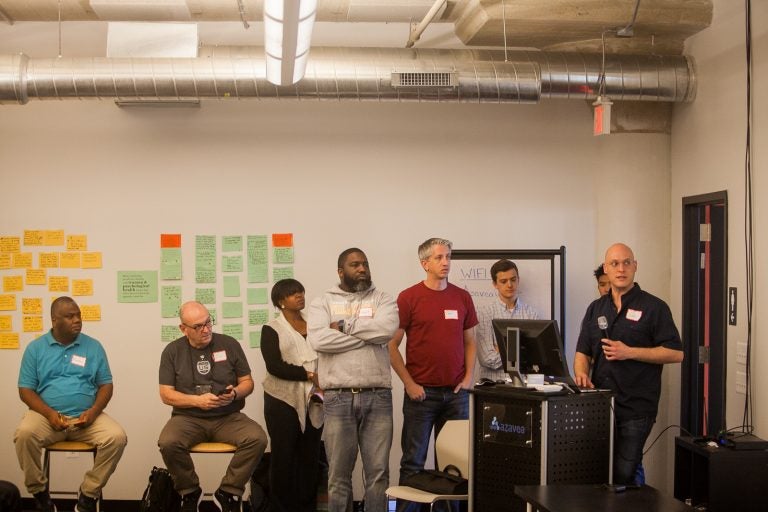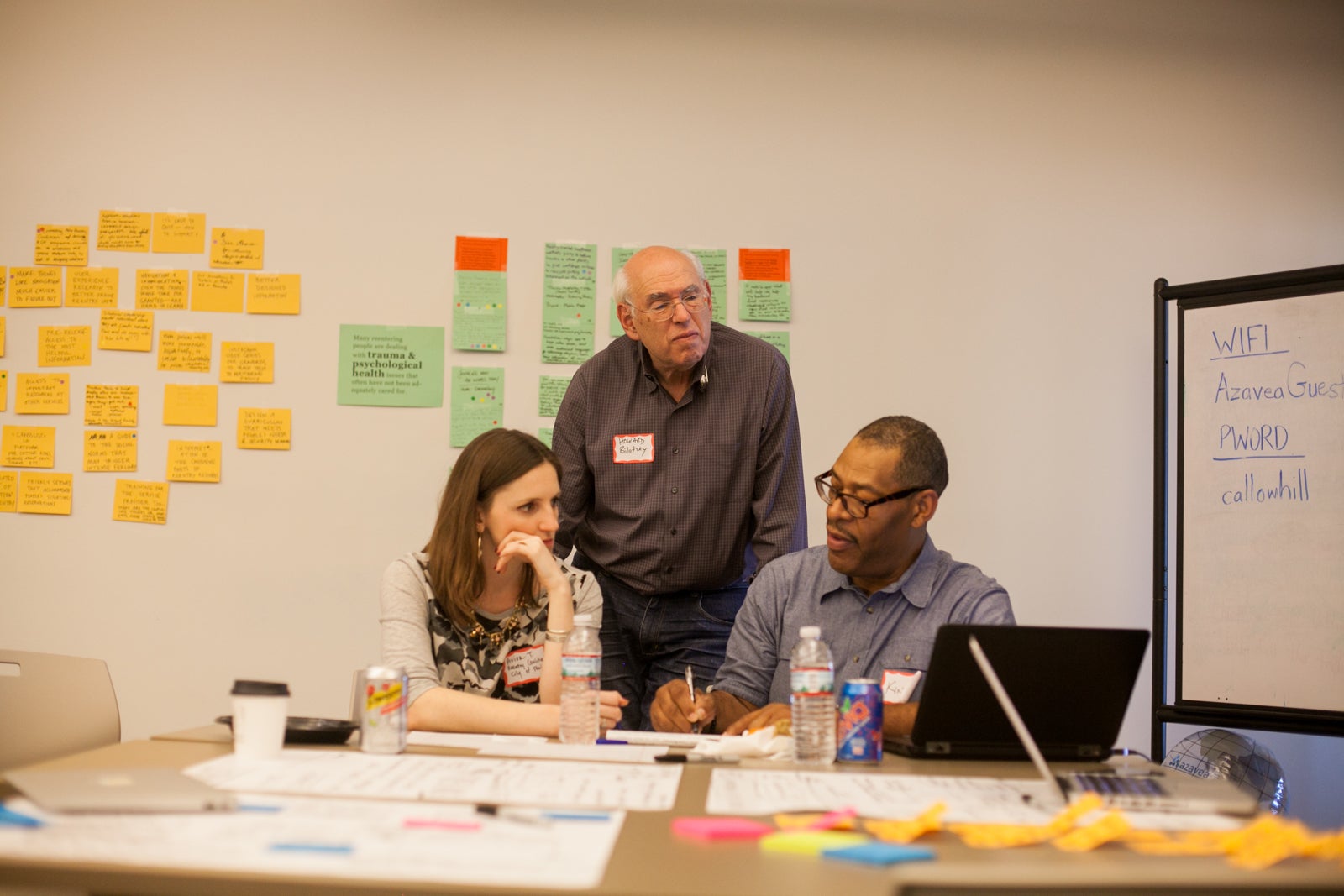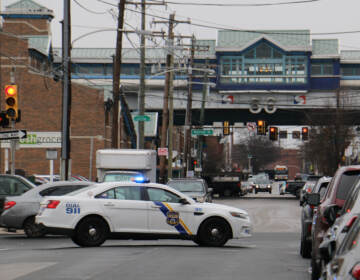At Philly reentry ‘hackathon,’ using tech to drive down recidivism
About 35 volunteers spent their Saturday working together to harness the power of technology to help people coming out of prison rebuild their lives.

Teams presented their ideas to use technology to help formerly incarcerated people return to their communities at a 'hackathon' in Philadelphia organized by The Reentry Project. (Brad Larrison for WHYY)
Jeff Abramowitz knows firsthand that the biggest problem confronting formerly-incarcerated people in Philadelphia is knowing where to go and how to get support once they leave the prison system. He’s been out of prison for more than two years and owns a workforce development agency.
After hustling through an eight-hour “hackathon” on Saturday, Abramowitz may have the start of a solution: a bilingual website called “Mission: Reentry” that would provide people with “the essential services and information to get their lives back together — not in six months, but right this minute,” he said.
Abramowitz collaborated with one of four teams who spent the day working together to harness the power of technology to help people coming out of prison return to the Philadelphia community. The prison reentry process has long suffered from a lack of resources to help people get back on their feet. In Philadelphia, some 200,000 to 300,000 people have criminal records. About 60 percent of those released from prison will be rearrested again within three years.
“With reentry, it’s not like there are a ton of obvious technical solutions,” said said Dawn McDougall, the Executive Director of Code for Philly, a nonprofit that uses data and technology as a mode of civic engagement. “It’s complex because there are so many systems that touch a person as they’re coming out and trying to reintegrate into society. We knew the goal for this hackathon was going to be the collaboration.”
Code for Philly hosted the event along with The Reentry Project, a collaboration among 15 newsrooms in our region, including WHYY, doing solutions-oriented reporting on the issue of prisoner reentry in Philadelphia.
The roughly 35 hackathon volunteers came from a variety of backgrounds, including coders, formerly incarcerated people, data journalists and reentry service providers.
On Friday night, about 50 people gathered to identify some core challenges of reentry and brainstorm points of intervention where technology could help. Teams formed Saturday morning around three big issues: employment, reentry-related information, as well as trauma and psychological health.
Abramowitz’s team presented the bilingual website, which included pages of resources from employment to housing to legal help. And since most halfway houses don’t allow internet access, the team also created a text application allowing flip-phone users to text “1” for job help or “2” for housing help resources, for example.
“I have not had an opportunity to collaborate from a technology end with people that have this talent and we were in a matter of a few hours able to put together an entire website, which could be so helpful to so many people,” Abramowitz said.
Another team created an application to connect formerly-incarcerated people with local mentors. When they create an account, mentees or mentors can choose categories they want help with or could provide resources for, such as employment, housing and spirituality. The app also integrates with Slack, a messaging system, to let mentors and mentees chat in themed channels.

“The idea is that those peers could be folks who have already come back from incarceration and already figured out some of the things that need to happen in terms of going to get an ID and maybe where to find food,” said Kistine Carolan, data services manager with the city’s Office of Open Data & Digital Transformation. “It could also be for people who have not gone through that experience, but want to be able to help out in some way. If I have skills in editing a resume, I can offer those up.”
Rocco Dicicco worked as a social worker in the criminal justice system for nearly a decade. His team created a “low-fi” solution to help people find resources if they don’t have a lot of technology at their fingertips.
“Anybody, even with a really simple basic cell phone, can send a text and find out where a computer lab is, find out where a food resource is or a clothing source based on their locations,” he said.
The final hackaton team created an app for family, friends and community members looking to help formerly incarcerated people before and after their release.
“If they need help with one particular area — maybe it’s housing, maybe it’s preparing for employment, maybe it’s preparing for a behavioral health treatment— they can go do a deeper dive and we’ll give them more than just a roadmap, but a lot of resources they should try to connect with,” said Luke McKinstry, an application programmer analyst at the company Communally.
Unlike other hackathons, this event emphasized collaboration over competition. The Reentry Project Editor Jean Friedman-Rudovsky said the goal was not to walk away with a fully-working app after just a few hours.
“What we hope to come out of this is just possibilities for collaboration down the road, in the sense that we’re bringing people together who maybe had never talked to someone who was formerly incarcerated. Or formerly incarcerated people, bringing them together with folks who have high-level design and technology skills,” she said. “The possibilities are kind of endless in terms of continuing this work together.”
Some of the hackathon volunteers will present their ideas at The Reentry Blueprint event, a series of TED-style talks by formerly incarcerated people, that will be held at The Franklin Institute on November 15.
WHYY is one of 15 news organizations in the Philadelphia Reentry Reporting Collaborative, a solutions-oriented focus on the issues facing formerly incarcerated Philadelphians. The aim is to produce journalism that speaks, across the city and across media platforms, to the challenges and solutions for reentry.
WHYY is your source for fact-based, in-depth journalism and information. As a nonprofit organization, we rely on financial support from readers like you. Please give today.





